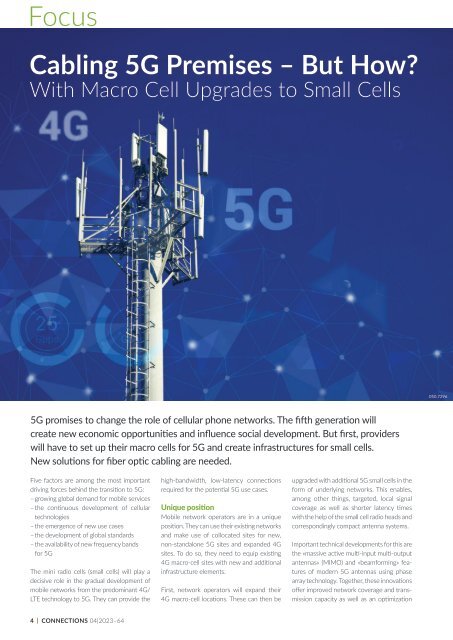CONNECTIONS_64-e
R&M specialist magazine CONNECTIONS no. 64
R&M specialist magazine CONNECTIONS no. 64
You also want an ePaper? Increase the reach of your titles
YUMPU automatically turns print PDFs into web optimized ePapers that Google loves.
Focus<br />
Cabling Megatrend 5G Premises – But How?<br />
With Macro Cell Upgrades to Small Cells<br />
050.7296<br />
5G promises to change the role of cellular phone networks. The fifth generation will<br />
create new economic opportunities and influence social development. But first, providers<br />
will have to set up their macro cells for 5G and create infrastructures for small cells.<br />
New solutions for fiber optic cabling are needed.<br />
Five factors are among the most important<br />
driving forces behind the transition to 5G:<br />
– growing global demand for mobile services<br />
– the continuous development of cellular<br />
technologies<br />
– the emergence of new use cases<br />
– the development of global standards<br />
– the availability of new frequency bands<br />
for 5G<br />
The mini radio cells (small cells) will play a<br />
decisive role in the gradual development of<br />
mobile networks from the predominant 4G/<br />
LTE technology to 5G. They can provide the<br />
high-bandwidth, low-latency connections<br />
required for the potential 5G use cases.<br />
Unique position<br />
Mobile network operators are in a unique<br />
position. They can use their existing networks<br />
and make use of collocated sites for new,<br />
non-standalone 5G sites and expanded 4G<br />
sites. To do so, they need to equip existing<br />
4G macro-cell sites with new and additional<br />
infrastructure elements.<br />
First, network operators will expand their<br />
4G macro-cell locations. These can then be<br />
upgraded with additional 5G small cells in the<br />
form of underlying networks. This enables,<br />
among other things, targeted, local signal<br />
coverage as well as shorter latency times<br />
with the help of the small cell radio heads and<br />
correspondingly compact antenna systems.<br />
Important technical developments for this are<br />
the «massive active multi-input multi-output<br />
antennas» (MIMO) and «beamforming» features<br />
of modern 5G antennas using phase<br />
array technology. Together, these innovations<br />
offer improved network coverage and transmission<br />
capacity as well as an optimization<br />
4 | <strong>CONNECTIONS</strong> 04|2023–<strong>64</strong>

















